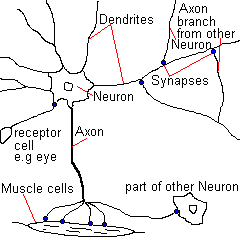| Neurons are, in life of humans and animals, cells, which play an important role in the thinking processes. The membranes (hulls) of the neurons are electrically loaded, and if the load exceeds a certain level (called threshold potential) the neuron "fires", which means the electric load runs as an impulse along an "Axon" (Axon is a nerve-connection (like a cable) that runs away from a neuron and a Dendrite is one which run towards a cell (means for one neuron a nerve connection is an Axon for an other a Dendrite)), which splits in several branches, towards other cells. This branches leads to other neuronal cells or other cells in the body, they are connected towards each other by a "synapse". There are two sorts of synapses, the first named excitatory synapse, the other inhibitory synapse. If an impulse reaches a cell via an excitatory synapse the electrical load of the cell is increased and if the cell's threshold potential is exceeded it will fire if it is a neuron or perform a pull if it is a muscle cell. If the impulse reaches the neuron via an inhibitory synapse the neuron is stopped from firing for a certain time. Although this is known since 1941, scientists have not yet succeeded in creating an model for neuron and connections which describes why and how these processes lead to intelligence and consciousness
|



